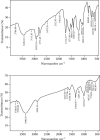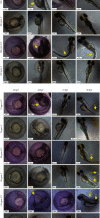Toxicity Mitigation of Textile Dye Reactive Blue 4 by Hairy Roots of Helianthus annuus and Testing Its Effect in In Vivo Model Systems
- PMID: 35924274
- PMCID: PMC9343192
- DOI: 10.1155/2022/1958939
Toxicity Mitigation of Textile Dye Reactive Blue 4 by Hairy Roots of Helianthus annuus and Testing Its Effect in In Vivo Model Systems
Abstract
An anthraquinone textile dye, Reactive Blue 4 (RB4), poses environmental health hazards. In this study, remediation of RB4 (30-110 ppm) was carried out by hairy roots (HRs). UV-visible spectroscopy and FTIR analysis showed that the dye undergoes decolourization followed by degradation. In addition, toxicity and safety analyses of the bioremediated dye were performed on Allium cepa and zebrafish embryos, which revealed lesser toxicity of the bioremediated dye as compared to untreated dye. For Allium cepa, the highest concentration, i.e., 110 ppm of the treated dye, showed less chromosomal aberrations with a mitotic index of 8.5 ± 0.5, closer to control. Two-fold decrease in mortality of zebrafish embryos was observed at the highest treated dye concentration indicating toxicity mitigation. A higher level of lipid peroxidation (LPO) was recorded in the zebrafish embryo when exposed to untreated dye, suggesting a possible role of oxidative stress-inducing mortality of embryos. Further, the level of LPO was significantly normalized along with the other antioxidant enzymes in embryos after dye bioremediation. At lower concentrations, mitigated samples displayed similar antioxidant activity comparable to control underlining the fact that the dye at lesser concentration can be more easily degraded than the dye at higher concentration.
Copyright © 2022 Kanchanlata Tungare et al.
Conflict of interest statement
The authors declare that there is no conflict of interest regarding the publication of this article.
Figures







Similar articles
-
Remediation of textile azo dye acid red 114 by hairy roots of Ipomoea carnea Jacq. and assessment of degraded dye toxicity with human keratinocyte cell line.J Hazard Mater. 2016 Jul 5;311:158-67. doi: 10.1016/j.jhazmat.2016.02.058. Epub 2016 Feb 28. J Hazard Mater. 2016. PMID: 26971029
-
Biodecolorization of azo dye Remazol orange by Pseudomonas aeruginosa BCH and toxicity (oxidative stress) reduction in Allium cepa root cells.Appl Biochem Biotechnol. 2012 Nov;168(5):1319-34. doi: 10.1007/s12010-012-9860-z. Epub 2012 Sep 5. Appl Biochem Biotechnol. 2012. PMID: 22948606
-
Effect of light on the kinetics and equilibrium of the textile dye (Reactive Red 120) adsorption by Helianthus annuus hairy roots.Bioresour Technol. 2018 Jun;257:84-91. doi: 10.1016/j.biortech.2018.02.075. Epub 2018 Feb 20. Bioresour Technol. 2018. PMID: 29486410
-
Degradation analysis of Reactive Red 198 by hairy roots of Tagetes patula L. (Marigold).Planta. 2009 Sep;230(4):725-35. doi: 10.1007/s00425-009-0980-9. Epub 2009 Jul 18. Planta. 2009. PMID: 19618207
-
Differential Expression of Antioxidant Enzymes During Degradation of Azo Dye Reactive black 8 in Hairy roots of Physalis minima L.Int J Phytoremediation. 2015;17(1-6):305-12. doi: 10.1080/15226514.2013.876963. Int J Phytoremediation. 2015. PMID: 25409242
Cited by
-
Accelerated biodecolorization and detoxification of synthetic textile dye Acid Maroon V by bacterial consortium under redox mediator system.3 Biotech. 2023 Feb;13(2):51. doi: 10.1007/s13205-023-03466-6. Epub 2023 Jan 17. 3 Biotech. 2023. PMID: 36685318 Free PMC article.
References
-
- Forss J., Welander U. Biodegradation of azo and anthraquinone dyes in continuous systems. International Biodeterioration & Biodegradation- INT BIODETERIOR BIODEGRAD . 2011;65(1):227–237. doi: 10.1016/j.ibiod.2010.11.006. - DOI
MeSH terms
Substances
LinkOut - more resources
Full Text Sources

